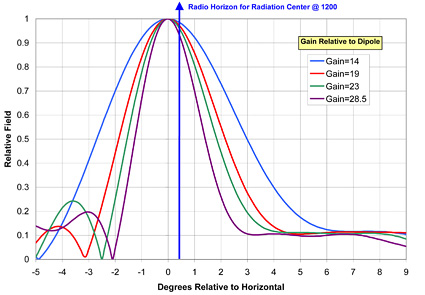DTV Reception 24 7

The first time I received an e-mail about DTV reception only during daylight hours, I was dubious. More recently, a reader in Humboldt County, Calif. wrote that reception in his town folds at sundown. He wrote that "grow lamps" are automatically switched on in many homes then. Those fluorescent lamp fixtures have solid-state ballasts that generate and radiate a lot of noise that falls within the low-band VHF channels. There's a local station on Channel 3 there. He also explained that there's a thriving agricultural industry in growing marijuana plants for fun and profit in the county. This man-made noise problem is fairly minor today, as there are only 38 low-band VHF band full power stations still in operation.
Amusing?
Other reports have trickled in so I've given some attention to other possibilities.
VERTICAL BEAM PROFILE
UHF band transmitting antennas achieve high gain by concentrating their field strength in a very small vertical angle. In many cases, a small amount of beam tilt aims this narrow beam slightly below the horizon. This is called beam tilt and it helps people living near the edge of the noise-limited coverage. Now consider that somehow or another, this beam tilt varies between day and night. The maximum field strength out there will vary accordingly from day to night.
UHF TV transmitting antennas have a very narrow vertical beam profile. This gives them their high gain. To obtain high gain, the antenna must be many wavelengths from bottom to top. This explains why high-gain antennas are practical only in the UHF band. For example the wavelength is 0.5 meters, 20 inches at Channel 35 (596–602 MHz).

Fig. 1: Typical Elevation Patterns of TV Antennas Fig. 1, courtesy of Oded Bendov, shows the vertical beam profile for an antenna with gain from 14 to 28.5. These antennas have zero beam tilt—the maximum field strength is in a horizontal plane passing through the center of radiation of the antenna. This plane extends to the radio horizon. These gains are not in dB, a gain of 14 "antenna" would be 14 wavelengths from top to bottom: 280 feet or about 24 feet for Channel 35; however, at Channel 3's wavelength it would have to be 240 feet tall.
In Fig. 1, you can see that the higher the gain, the narrower is the vertical beam profile and that the field strength decreases very rapidly at locations below the horizontal. Where the line-of-sight from the antenna to the receive antenna is 1 degree below the horizon, the highest gain antenna has a field strength of 0.7 of what it is in the horizontal plane. If the beam tilt were to vary by from 0 to 1 degree, there would be a 6 dB decrease in field strength. Field strength is given in volts per meter (V/m), while we are interested in the received power in dBm from the antenna.
At a small change from zero degrees relative to horizontal in Fig. 1, the slope of field strength versus degrees from H is very steep especially for the higher gain Tx antennas, those with very narrow vertical beam profiles. For example, at 0.6 degrees relative to horizontal, a change in beam tilt from zero to 0.6 degrees, the field strength drops from 0.7 to 0.6. Now consider that the received power when the receiver is working is say, 83 dBm corresponding to the field strength of 0.7. When it drops to 0.6 the received signal power is below threshold (nominally –84 dBm).
Where does this lead us?
It suggests that small changes in beam tilt can result in loss of reception near the edge of coverage of a UHF facility, and especially for those with high-gain antennas.
THE MECHANICS OF BEAM TILT
So what might cause beam tilt to vary from day to night? Beam tilt can be introduced mechanically by means of a wedge beneath the antenna footing, or it can be accomplished electrically. Imagine two dipoles vertically stacked one wavelength apart and fed by the same feed line. If this transmission line is feeding a power splitter and that feeds both dipoles with identical lengths of coax, there would be zero beam tilt.
Now to introduce a desired beam tilt, one of these coax lines would be lengthened a bit so that the currents to these dipoles are slightly out-of-phase. That is electronic beam tilt. Now consider the length of this line when heated by the sun, versus when it's cooled at night by radiation and cold air.
This is one model which would explain how beam tilt might be different day to night.
In a high gain antenna as noted above, the difference in coax line lengths to feed the upper half of versus the lower half of the antenna is large and the resulting phase changes may be appreciable with high gain antennas.
Sounds hopeless, doesn't it? Stay tuned for the good news, it is not hopeless.
Charles Rhodes is a consultant in the field of television broadcast technologies and planning. He can be reached via email at cwr@bootit.com.
Get the TV Tech Newsletter
The professional video industry's #1 source for news, trends and product and tech information. Sign up below.
